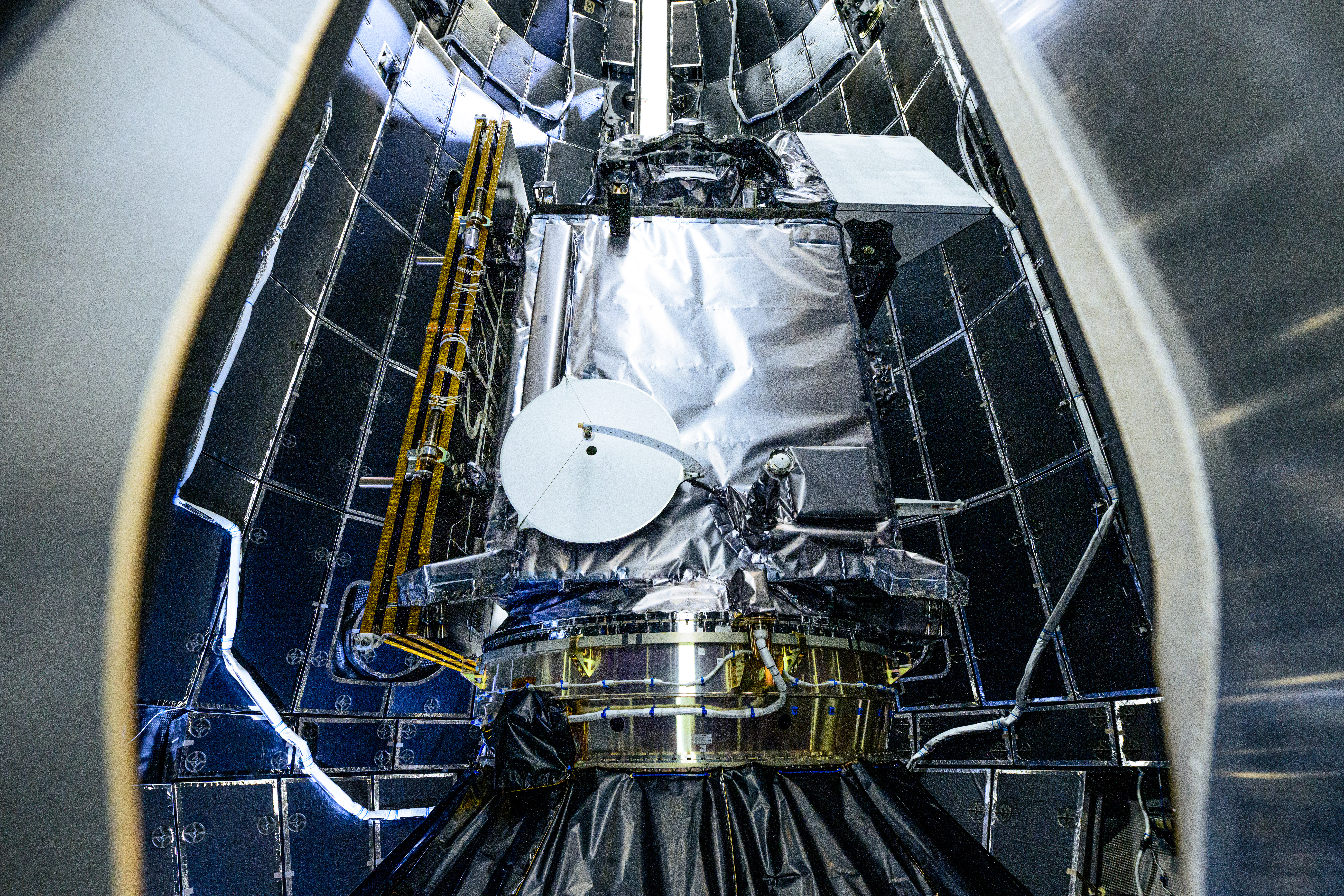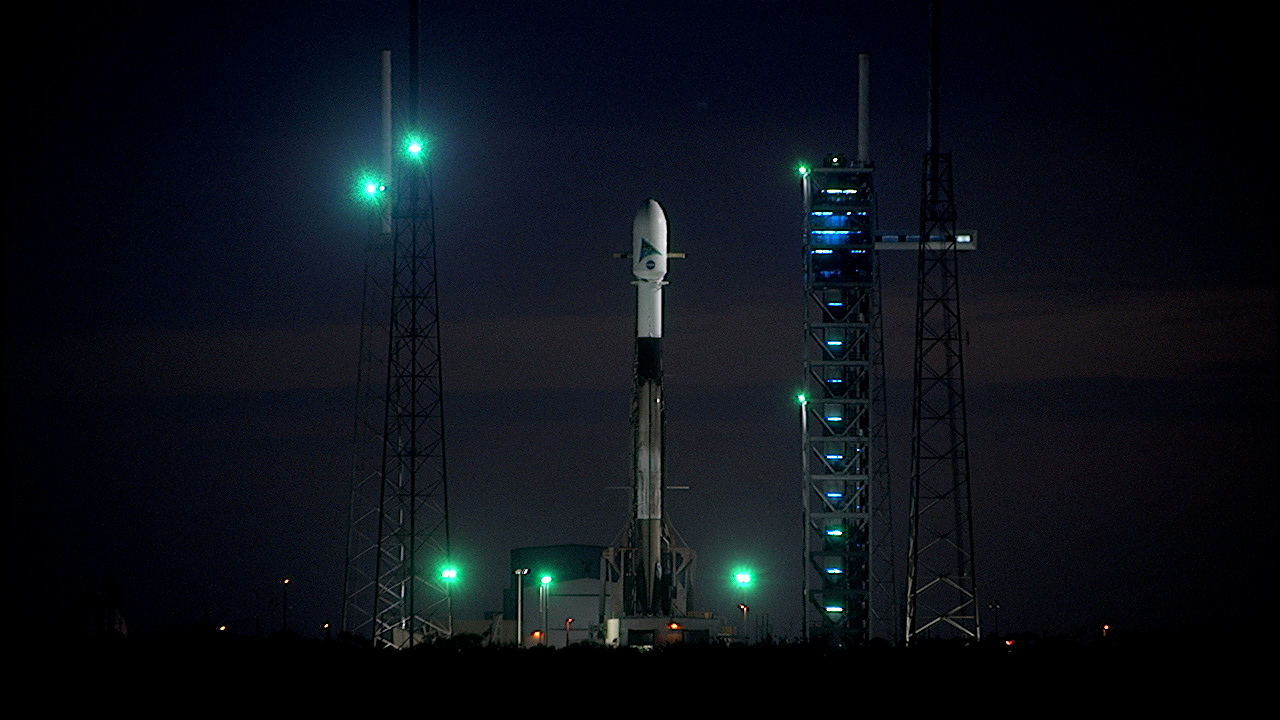
NASA’s PACE (Plankton, Aerosol, Cloud, ocean Ecosystem) spacecraft has separated from the Falcon 9 rocket’s second stage, beginning its science mission from sun-synchronous orbit about 420 miles above the Earth’s surface.

NASA’s PACE (Plankton, Aerosol, Cloud, ocean Ecosystem) spacecraft has separated from the Falcon 9 rocket’s second stage, beginning its science mission from sun-synchronous orbit about 420 miles above the Earth’s surface.

The SpaceX Falcon 9 rocket’s first stage has successfully landed at Landing Zone 1 at Cape Canaveral Space Force Station in Florida. Tonight’s mission marks the fourth completed flight for this Falcon 9.

A series of rapid events occurs after launch. After Max Q – the moment of peak mechanical stress on the rocket – the nine Merlin engines of the Falcon 9’s first stage will finish their burn and cut off during a phase called MECO or Main Engine Cutoff.
Quickly after MECO, the stage separation sequence occurs. The second stage carrying NASA’s PACE (Plankton, Aerosol, Cloud, ocean Ecosystem) spacecraft will continue on its journey to sun-synchronous orbit.
Coming up next, the Falcon 9’s second stage engine ignites, and the protective payload fairings will be jettisoned to reveal NASA’s PACE (Plankton, Aerosol, Cloud, ocean Ecosystem) spacecraft to the vacuum of space for the first time.
Meanwhile, the first stage of the rocket begins its recovery journey for a vertical landing at SpaceX Landing Zone 1 at Cape Canaveral Space Force Station in Florida. Landing should occur about eight and a half minutes after liftoff.
Stay right here on the blog for more live mission coverage.

3, 2, 1 … LIFTOFF! A SpaceX Falcon 9 rocket carrying NASA’s PACE (Plankton, Aerosol, Cloud, ocean Ecosystem) spacecraft launched on a SpaceX Falcon 9 rocket from Cape Canaveral Space Force Station’s Space Launch Complex 40 at 1:33 a.m. EST Thursday, Feb. 8.
The next milestone is Max Q or maximum dynamic pressure – the moment of peak mechanical stress on the rocket.
Continue following live coverage of launch milestones here on the blog, or watch live coverage on the NASA+ streaming service, NASA Television, the NASA app, YouTube, and the agency’s website. Learn how to stream NASA TV through a variety of platforms, including social media.

NASA’s senior launch manager, Tim Dunn, has just given NASA’s PACE (Plankton, Aerosol, Cloud, ocean Ecosystem) mission the “go” for launch!
In the next few moments, the SpaceX Falcon 9 rocket’s nine Merlin engines will roar to life at Cape Canaveral Space Force Station’s Space Launch Complex 40, sending the PACE spacecraft on the start of its journey to a sun-synchronous orbit to study the Earth’s atmosphere and ocean surface from space.
Liftoff remains on track for 1:33 a.m. EST.

When NASA’s PACE (Plankton, Aerosol, Cloud, ocean Ecosystem) mission launches at 1:33 a.m. EST from Space Launch Complex 40 at Cape Canaveral Space Force Station, the SpaceX Falcon 9 rocket will follow a little used flight path, or trajectory.
After liftoff, the rocket will head south along the Florida coastline during its powered flight to insert the spacecraft into a sun-synchronous orbit. That means the spacecraft will always be in the same “fixed” position relative to the Sun as it orbits over the Earth’s polar regions.
Provided the nighttime skies over South Florida are clear, millions of residents will be able to look up and see the Falcon 9 overhead within minutes after launch.

As NASA and SpaceX teams continue to work toward liftoff of the agency’s PACE (Plankton, Aerosol, Cloud, ocean Ecosystem) mission aboard a Falcon 9 rocket scheduled for 1:33 a.m. EST, here’s a look at some facts about the spacecraft and the science instruments on board:
Continue following live countdown coverage and upcoming launch milestones right here on the blog.

NASA’s newest Earth-observing satellite called PACE (Plankton, Aerosol, Cloud, ocean Ecosystem) is dedicated to climate science and helping researchers learn more about the relationship between the atmosphere and ocean.
Satellite observation technology to study Earth’s atmosphere and oceans has been used for decades, but with a spectrometer and two polarimeters onboard, PACE will provide a major leap forward by providing new data on clouds, aerosols, and phytoplankton in our oceans.
PACE will enable new views of clouds and aerosols within the atmosphere, and microscopic phytoplankton in the ocean that can help to reveal more about climate change’s impact on marine life and ocean health.
Changes in phytoplankton populations can appear as different colors on the ocean surface and with PACE, these color variations will be more discernible. Phytoplankton also interact with microscopic airborne particles called aerosols. Clouds form in the atmosphere when water vapor condenses on these particles. Aerosols can sometimes be the result of wildfires and pollution. Often, the particles end up deposited on the ocean surface which can encourage phytoplankton blooms.
Scientists will use data from PACE’s instruments to measure size, composition, and amount of aerosols present within the atmosphere. This information will help scientists better understand how clouds and aerosols interact and what that impact is on ocean health. Together, these puzzle pieces can reveal larger insights about climate change.
The SpaceX Falcon 9 rocket will follow a path along a southern polar trajectory and insert PACE into a sun-synchronous orbit. Liftoff is scheduled for 1:33 a.m. EST.
NASA’s Goddard Space Flight Center is responsible for the mission including the design and fabrication of the spacecraft and the development of its instruments. The agency’s Launch Services Program (LSP) based at NASA’s Kennedy Space Center in Florida manages the launch service for the mission.
PACE is LSP’s first launch to polar orbit from Florida’s Space Coast, and it’s the first for NASA since 1960. Other launches to polar orbit have been from Vandenberg Space Force Base in California. SpaceX has launched to a polar orbit from Florida for other customers.
To learn more about PACE, visit:
https://science.nasa.gov/mission/pace
Stay right here for continued blog coverage, or tune in to the launch broadcast on NASA Television, NASA+, the NASA app, and the agency’s website, as well as YouTube, X, Facebook, Twitch, and Daily Motion.

Here’s a look at some of the milestones for this morning’s countdown, liftoff, and ascent of NASA’s PACE (Plankton, Aerosol, Cloud, ocean Ecosystem) mission from Cape Canaveral Space Force Station in Florida. All times are approximate:
COUNTDOWN :
Hr/Min/Sec Event
– 00:38:00 SpaceX Launch Director verifies go for propellant load
– 00:35:00 RP-1 (rocket grade kerosene) loading begins
– 00:35:00 1st stage LOX (liquid oxygen) loading begins
– 00:16:00 2nd stage LOX loading begins
– 00:07:00 Falcon 9 begins engine chill prior to launch
– 00:01:00 Command flight computer to begin final prelaunch checks
– 00:01:00 Propellant tank pressurization to flight pressure begins
– 00:00:45 SpaceX Launch Director verifies go for launch
– 00:00:03 Engine controller commands engine ignition sequence to start
00:00:00 Falcon 9 liftoff
LAUNCH, LANDING, AND SPACECRAFT DEPLOYMENT:
Hr/Min/Sec Event
00:01:07 Max Q (moment of peak mechanical stress on the rocket)
00:02:19 1st stage main engine cutoff (MECO)
00:02:23 1st and 2nd stages separate
00:02:30 2nd stage engine starts
00:02:36 Boostback Burn Starts
00:03:16 Boostback Burn Ends
00:04:15 Fairing deployment
00:05:46 1st stage entry burn start
00:06:11 1st stage entry burn ends
00:06:58 1st stage landing burn start
00:07:32 1st stage landing
00:10:20 2nd stage engine cutoff (SECO-1)
00:12:22 PACE spacecraft deploys

Launch weather officers with Cape Canaveral Space Force Station’s 45th Weather Squadron predict 95% favorable weather conditions for the launch of NASA’s PACE (Plankton, Aerosol, Cloud, ocean Ecosystem) mission aboard a SpaceX Falcon 9 rocket.
Liftoff continues to be targeted for 1:33 a.m. EST from Space Launch Complex 40 at Cape Canaveral Space Force Station Space in Florida.
Follow along here on the blog as the countdown continues, or watch live coverage on the NASA+ streaming service, the NASA app, and the agency’s website, as well as YouTube, and the agency’s website. Learn how to stream NASA TV through a variety of platforms, including these accounts on social media:
X: @NASA, @NASA_LSP, @NASAEarth, @NASAKennedy, @NASAGoddard
Facebook: NASA, NASA’s Launch Services Program, NASA’s Kennedy Space Center, NASA’s Goddard Space Flight Center
Instagram: @NASA, @NASAKennedy, @NASAGoddard